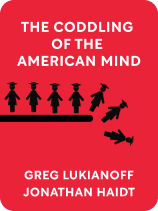

This article is an excerpt from the Shortform book guide to "The Coddling of the American Mind" by Greg Lukianoff and Jonathan Haidt. Shortform has the world's best summaries and analyses of books you should be reading.
Like this article? Sign up for a free trial here .
Is it possible for speech to be “violent”? Should speech that leads to physical harm be deemed violent? In what ways is this way of thinking harmful?
In their book, The Coddling of the American Mind, Jonathan Haidt and Greg Lukianoff argue that there is no such thing as violent speech, even if the speech in question does lead to physical harm of some form. They think that labeling speech as violent is an excuse to respond with physical violence in turn.
Keep reading to learn why Jonathan Haidt and Greg Lukianoff think that labeling speech as violent is harmful.
Speech as Violence
In The Coddling of the American Mind, Jonathan Haidt and Greg Lukianoff discuss the idea of violent speech, and whether or not speech can be violent.
In a 2017 New York Times essay, Northeastern University professor Lisa Feldman Barrett made the argument that certain forms of speech ought to be considered a form of violence.
The logic of this argument is that inflammatory speech can cause emotional distress. Emotional distress, in turn, can have harmful effects on one’s physical health. Therefore, since some forms of speech can lead to physical harm, such speech ought to be considered the moral equivalent of physical violence.
But this is a deceptively simple formulation. By this logic, almost anything could be considered an act of violence, since anything is likely to be emotionally stressful to at least someone. Anything that causes stress would therefore be considered “violent.” A parent telling their kids to clean their room or to do their homework (either of which might trigger stress) would be violent if one carried the premise of Barrett’s argument to its logical conclusion.
Of course, the authors argue, emotional stress—even if it leads to some level of physical harm—is not the same as violence—and neither is the speech that might cause emotional distress.
“Violent” Speech, Physically Violent Response
Jonathan Haidt and Greg Lukianoff argue that his attitude toward speech is extremely dangerous. They assert that concepts like “white supremacy” or “trauma” have lost much of their once-objective definition, becoming largely subjective in modern left-wing discourse.
These concepts have been watered down to encompass forms of speech and behavior that never used to fall under them. This makes the evaluation of what is “hateful” or “oppressive” entirely up to the listener. Regardless of what was said, if it caused anyone emotional harm, then it can be considered hate speech.
This then becomes an open invitation for a listener to respond to nearly any speech with which she disagrees with actual violence. After all, if one is being “violently” attacked (or believes that others are), then one has a right—indeed, a moral obligation—to respond in kind. Preemptively violent responses to speech (or even intended speech) become not acts of aggression, but rather, acts of self or community defense. If you oppose this physical violence, you are justifying and enabling “hate speech”—and making yourself a deserving target of physical violence.
Not only is this mode of thinking incompatible with the free expression of ideas, it is also psychologically damaging to those who subscribe to it. If you choose to interpret speech that does not 100 percent conform to your own beliefs as a personal and violent attack upon yourself, you will be severely limited in the variety of viewpoints to which you can reasonably be exposed. You will be intellectually impoverished and find your world becoming narrower, angrier, and duller.

———End of Preview———
Like what you just read? Read the rest of the world's best book summary and analysis of Greg Lukianoff and Jonathan Haidt's "The Coddling of the American Mind" at Shortform .
Here's what you'll find in our full The Coddling of the American Mind summary :
- The "three Untruths" that have taken hold of young people
- The damage that "speech codes" cause on college campuses
- How colleges are increasingly seeing students as customers






